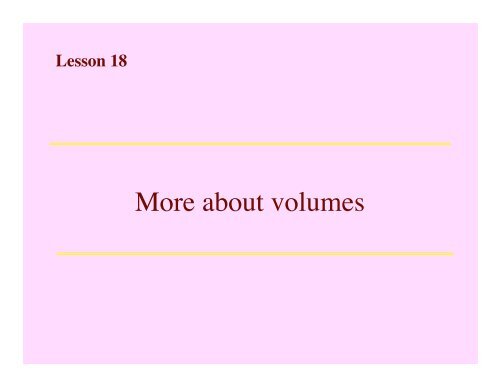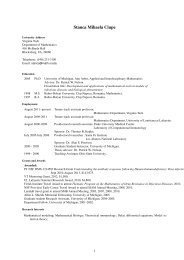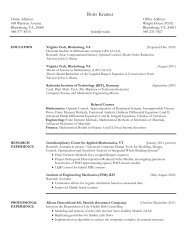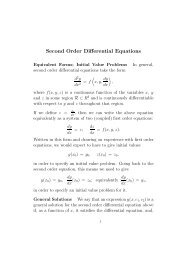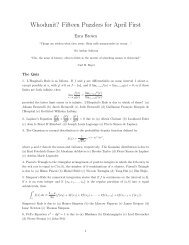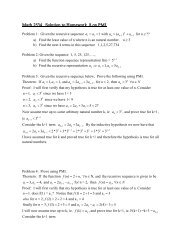More about volumes
More about volumes
More about volumes
You also want an ePaper? Increase the reach of your titles
YUMPU automatically turns print PDFs into web optimized ePapers that Google loves.
Lesson 18<br />
<strong>More</strong> <strong>about</strong> <strong>volumes</strong>
• Described how a plane region rotated <strong>about</strong> an<br />
axis describes a solid.<br />
• Found <strong>volumes</strong> of solids of revolution using<br />
b<br />
( ) 2 dh<br />
" ! r(h) = !r(h) 2 " dh<br />
a<br />
Last time<br />
• Determined the variable as given by the axis of<br />
rotation.<br />
b<br />
a
Last time group work<br />
Find the volume resulting when the curve y = 3x, on 1 ≤ x ≤ 3, is<br />
rotated…<br />
<strong>about</strong> the x-axis.<br />
V = ! ( r(x) ) 2<br />
3<br />
" dx = ! ( 3x ) 2 3<br />
" dx = ! 9x 2 3<br />
" dx<br />
1<br />
3<br />
3<br />
9x<br />
= !<br />
3 1<br />
= 3! x 3<br />
3<br />
1<br />
1<br />
= 3!(3 3 #1 3 ) = 78! $ 245units 3<br />
1
Find the volume resulting when the curve y = 3x, on 1 ≤ x ≤ 3, is<br />
rotated…<br />
<strong>about</strong> the y-axis.<br />
Last time group work<br />
"<br />
( ) 2<br />
V = ! r(y)<br />
= !<br />
9<br />
3<br />
9<br />
y 3<br />
9<br />
3 3<br />
= !<br />
27<br />
dy<br />
y 3<br />
= !<br />
9<br />
3<br />
"<br />
9<br />
3<br />
# y<br />
%<br />
$ 3<br />
&<br />
2<br />
( dy = !<br />
'<br />
"<br />
3<br />
9<br />
y<br />
9<br />
2<br />
dy<br />
= !<br />
9<br />
= !<br />
27 (93 ) 3 3 ) = 26! * 81.7units 3<br />
"<br />
3<br />
9<br />
y 2 dy
Few more examples of solids of revolution<br />
Example 1: Find the solid generated by revolving the region below<br />
the graph of<br />
f (x) = 0.5 + 0.2sin(12x) between x = 0.5 and x = 2.5.<br />
f (x) = 0.5 + 0.2sin(12x)<br />
#<br />
( )<br />
2.5 2<br />
0.5<br />
The solid<br />
V = ! 0.5 + 0.2sin(12 x) dx " 1.74 cubic units<br />
Use a numerical technique like Simpson’s rule
Few more examples of solids of revolution<br />
Example 2: Find the solid resulting from rotating<br />
for 0 ≤ x ≤ 0.5, <strong>about</strong> the z-axis.<br />
z = !2x +1<br />
z = !2x +1<br />
The solid<br />
2<br />
1 1<br />
# 1" z $ 1<br />
2 2 3<br />
! ! 1( 1 2 ) ! % 1 & ! .<br />
0 ' ( 0 4 4 ) 3 * 0 12<br />
- -<br />
V = dz = " z + z dz = z " z + z =<br />
+ 2 ,
1. Start with the picture. For solids of revolution, sketch the region<br />
involved first, then sketch the solid.<br />
2. Make sure that everything within the integral is in terms of the<br />
correct variable.<br />
The axis you rotate <strong>about</strong> gives the variable to use for a solid of<br />
revolution. When in doubt, refer to your diagrams.<br />
3. Simplify the integral.<br />
When working on volume problems:<br />
4. Integrate (find the antiderivative)<br />
5. Evaluate using the fundamental theorem.
Recall…<br />
Volume of a blob:<br />
Find cross sectional area at<br />
height h: A(h)<br />
Volume =<br />
General Volumes<br />
When the cross sections happen to be circles, we can use a<br />
simplified formula using the radius of each circle.<br />
But we cannot use this if the cross sections are not circles.
Example<br />
Find the volume of a cylinder that has an elliptical base<br />
with semi-major axis 5, semi-minor axis 4, and height 7.<br />
Area of ellipse:<br />
πab = π(4)(5) = 20π<br />
So A(z) = 20π, and<br />
volume =<br />
Minor Axis<br />
Major Axis
Examples for Practice<br />
examples 1 and 2 on pp. 2-3 in your notes from Lesson 18.<br />
Example 1: The Great Pyramid of Egypt is 410 feet high. Its base<br />
is a square 755 feet by 755 feet.<br />
Goal: find the volume of this solid.<br />
Need: find the cross-sectional area at any height h.<br />
(cross-sections are squares, we need to know the length of the side<br />
of the pyramid at each height h.
Example 1<br />
Great pyramid: square base, 755 ft by 755 ft and height 410 ft<br />
a) Show<br />
b) Area of square cross section at height h:<br />
similar triangles
c) Integral for volume:<br />
d)<br />
Example 1<br />
d) Compare your answer to the geometric formula a for the volume of a<br />
square pyramid of height h with base length s:<br />
V = 1<br />
3 s2h = 1<br />
3 (755)2 (410) = 77903416.67<br />
.
Example 2<br />
Set up an integral to find the volume of a half grapefruit whose diameter<br />
is 5 inches. (you may assume that the whole grapefruit is a sphere.)<br />
Each slice is a circle. Radius is given by x coordinate on<br />
a semi-circle, radius 2.5.<br />
Each slice is a circle. Radius is x
Example 2<br />
What if we cut off the top; what is the volume from<br />
height 0 to height 2?<br />
Only change: limits from z = 0 to z = 2:
Example 3<br />
Using Calculus: What is the volume of a waffle ice cream cone<br />
whose diameter is 3.5 inches and height is 7 inches?<br />
To find r, we need the equation of the side of the cone.<br />
Two points on the side of the<br />
cone are (0, 0) and (1.75, 7)<br />
Equation of line: y = mx + b<br />
With this example: y =<br />
7<br />
x = 4x<br />
1.75<br />
How does this help us? Vol = !(r(h)) 2 b<br />
" dh<br />
a<br />
What is r ?<br />
2 3<br />
7<br />
7 7<br />
2 y ! 2 ! y<br />
3<br />
b<br />
" #<br />
Vol = * ! ( r( h)) dh = ! dy y dy 22.45 units<br />
a * & ' = = $ %<br />
0 4 16 * 0<br />
( )<br />
16 3<br />
0
Example 4<br />
The integral represents the volume of either a hemisphere<br />
or a cone, and the variable of integration measures a<br />
length.<br />
!(81" h 2 #<br />
9<br />
) dh<br />
0<br />
a) Which shape is represented?<br />
!<br />
Vol = A(h) dh<br />
a<br />
b<br />
Since this shape is a hemisphere.<br />
!(81" h 2 ) = ! r 2<br />
b) Give the radius of the hemisphere OR the radius and<br />
height of the cone.<br />
81! h 2 = r 2 " r 2 + h 2 = 81 = 9 2<br />
The radius is 9 units.


